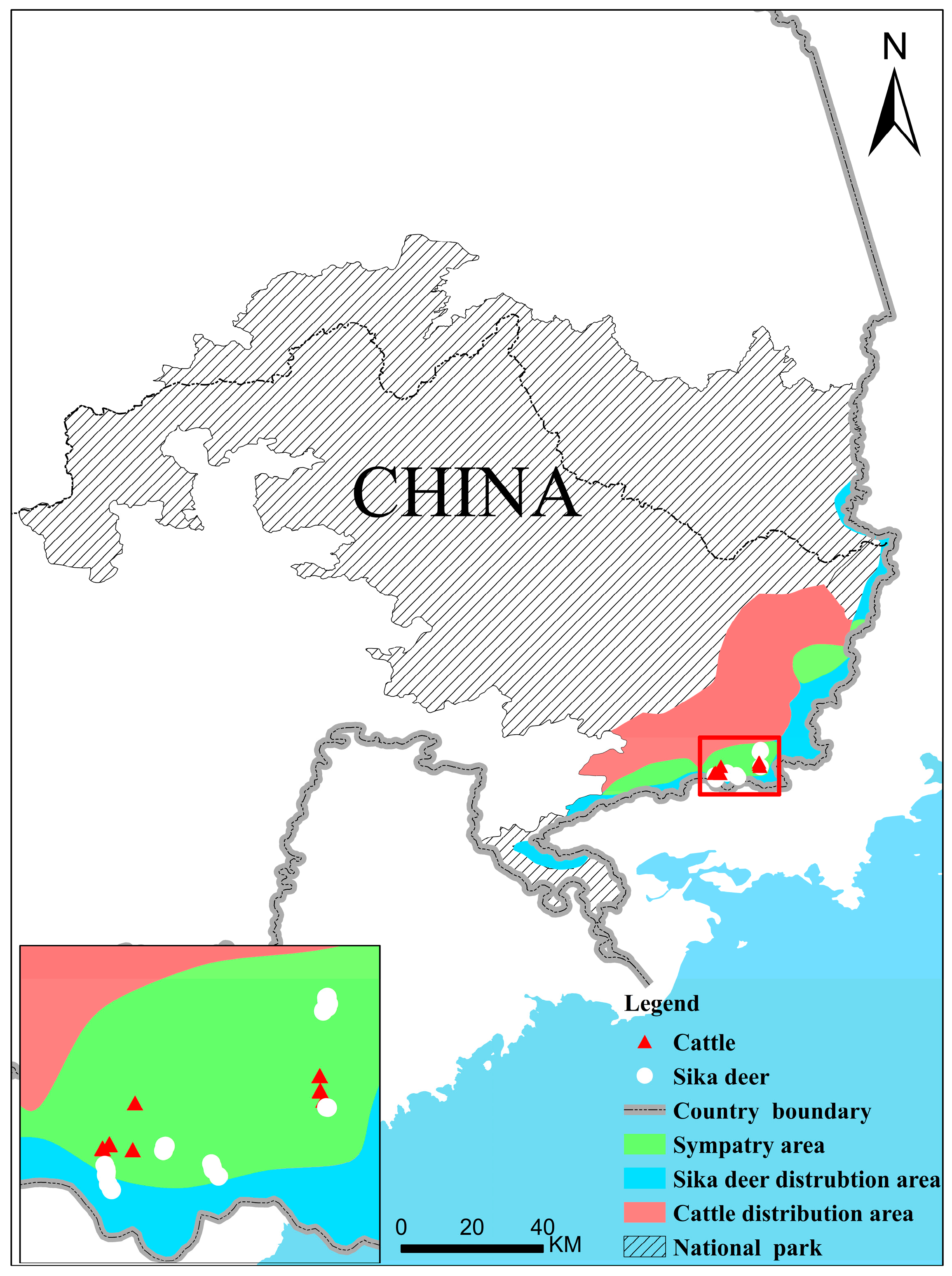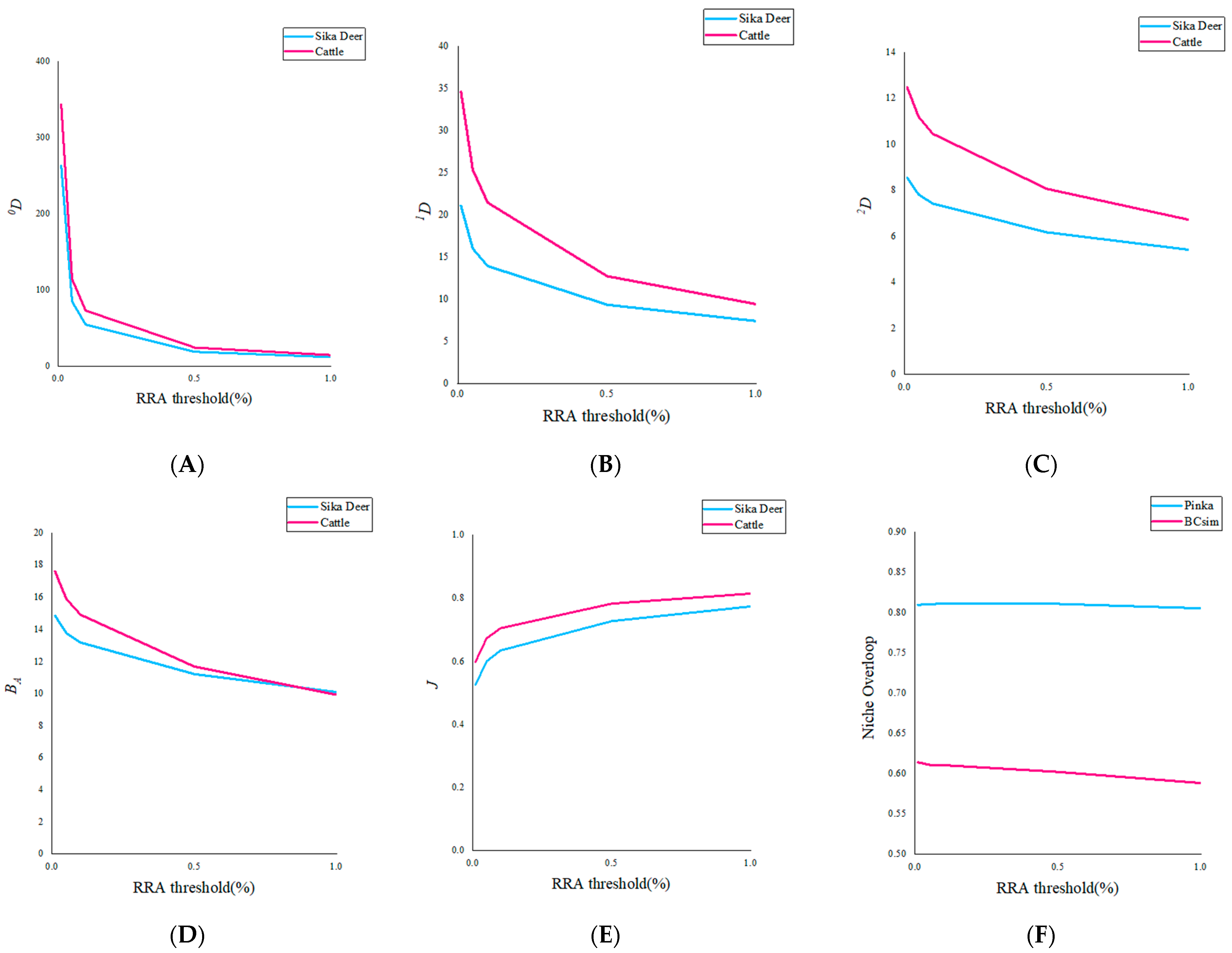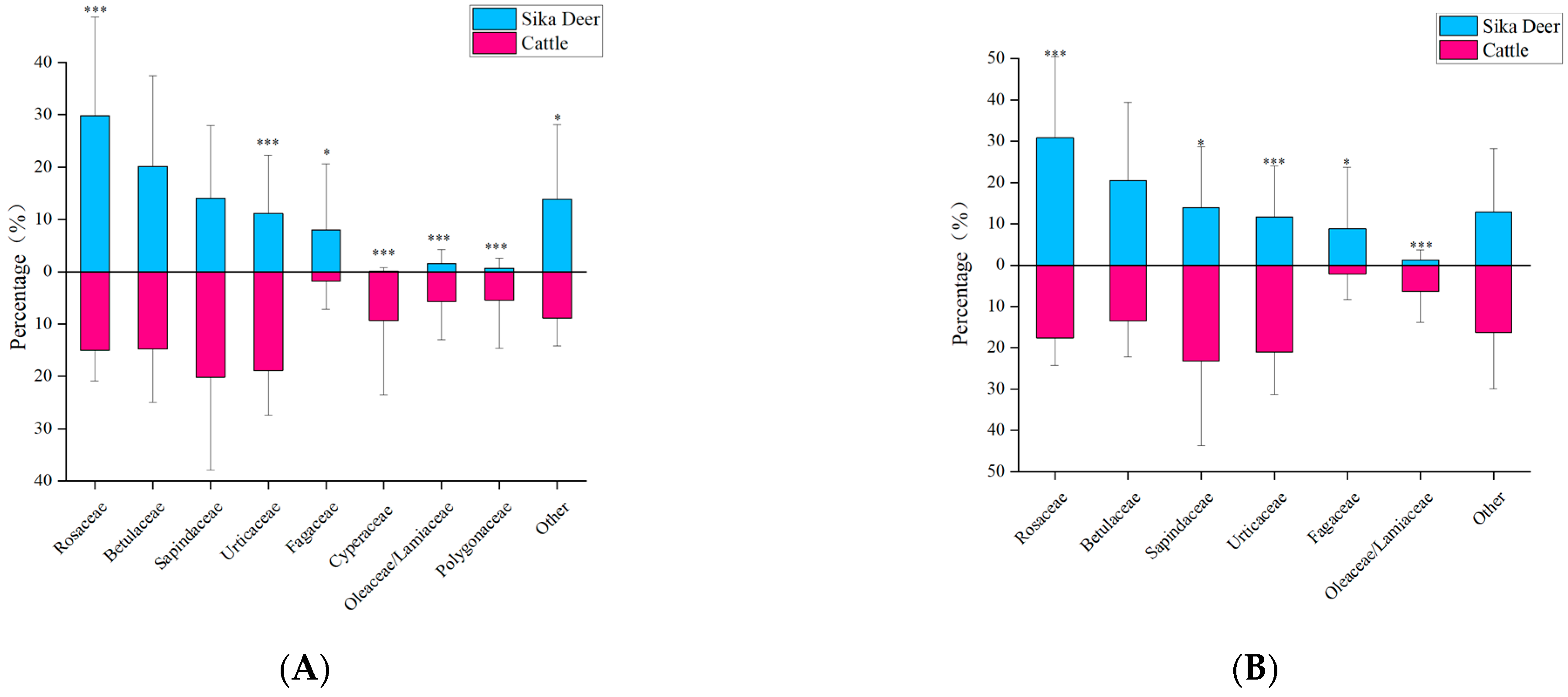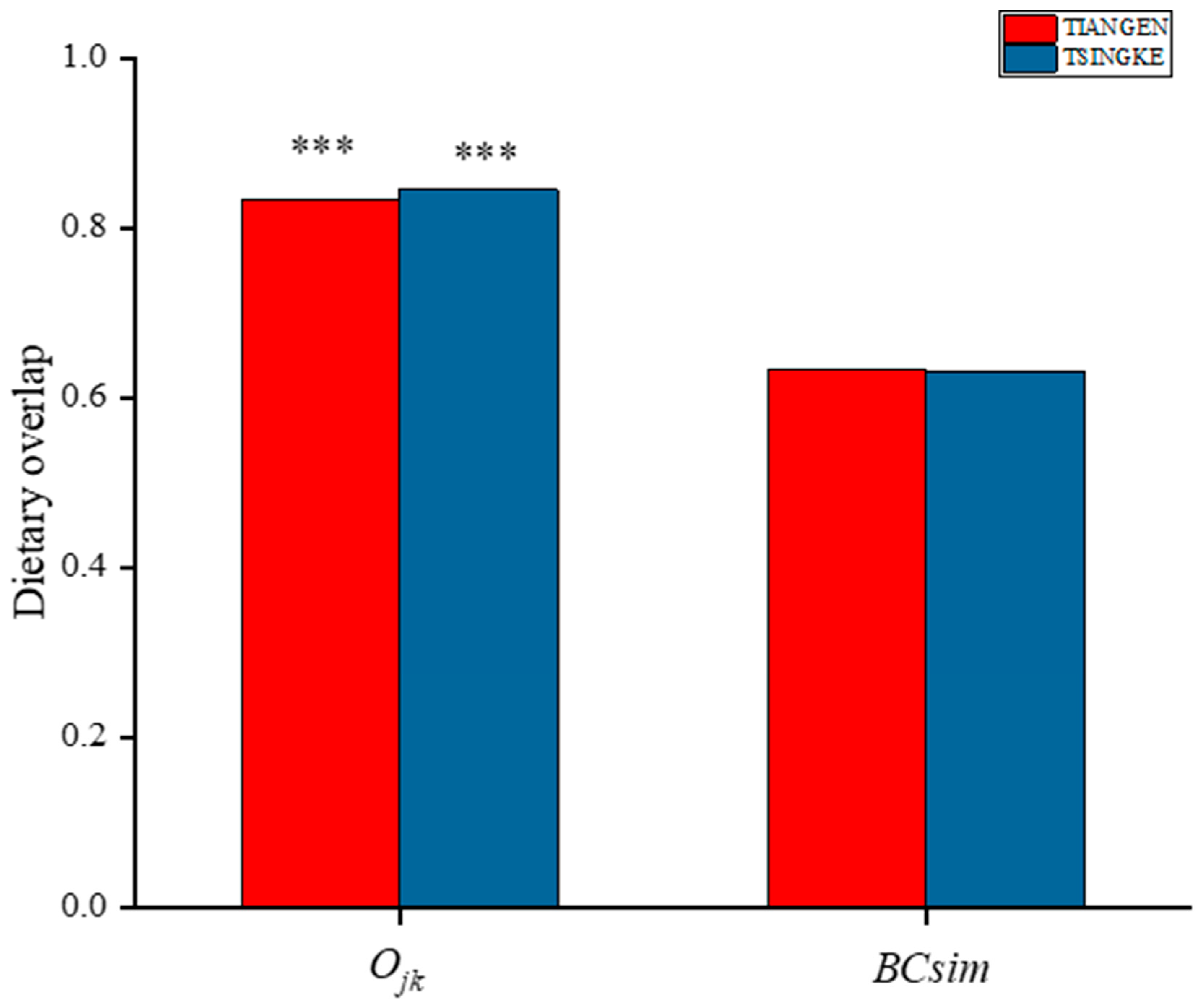Domestic Cattle in a National Park Restricting the Sika Deer Due to Diet Overlap
Abstract
Simple Summary
Abstract
1. Introduction
2. Materials and Methods
2.1. Study Areas and Sampling
2.2. DNA Extraction, PCR Amplification, and Sequencing
2.3. Sequence Analysis and Filtering
2.4. Dietary Pattern of Cattle and Sika Deer
2.5. Interspecific Dietary Differences and Overlaps
3. Results
3.1. Sample and Sequence Summary
3.2. Dietary Pattern of Sika Deer
3.3. Dietary Pattern of Cattle
3.4. The Extent of Dietary Overlaps between Sika Deer and Cattle
4. Discussion
5. Conclusions
Author Contributions
Funding
Institutional Review Board Statement
Informed Consent Statement
Data Availability Statement
Acknowledgments
Conflicts of Interest
References
- Tscharntke, T.; Clough, Y.; Wanger, T.C.; Jackson, L.; Motzke, I.; Perfecto, I.; Vandermeer, J.; Whitbread, A. Global food security, biodiversity conservation and the future of agricultural intensification. Biol. Conserv. 2012, 151, 53–59. [Google Scholar] [CrossRef]
- Fynn, R.W.S.; Augustine, D.J.; Peel, M.J.S.; de Garine-Wichatitsky, M. Strategic management of livestock to improve biodiversity conservation in African savannahs: A conceptual basis for wildlife-livestock coexistence. J. Appl. Ecol. 2016, 53, 388–397. [Google Scholar] [CrossRef]
- Zhang, W.; Ricketts, T.H.; Kremen, C.; Carney, K.; Swinton, S.M. Ecosystem services and dis-services to agriculture. Ecol. Econ. 2007, 64, 253–260. [Google Scholar] [CrossRef]
- Power, A.G. Ecosystem services and agriculture: Tradeoffs and synergies. Philos. Trans. R. Soc. B-Biol. Sci. 2010, 365, 2959–2971. [Google Scholar] [CrossRef]
- Pozo, R.A.; Cusack, J.J.; Acebes, P.; Malo, J.E.; Traba, J.; Iranzo, E.C.; Morris-Trainor, Z.; Minderman, J.; Bunnefeld, N.; Radic-Schilling, S.; et al. Reconciling livestock production and wild herbivore conservation: Challenges and opportunities. Trends Ecol. Evol. 2021, 36, 750–761. [Google Scholar] [CrossRef]
- van Eeden, L.M.; Crowther, M.S.; Dickman, C.R.; Macdonald, D.W.; Ripple, W.J.; Ritchie, E.G.; Newsome, T.M. Managing conflict between large carnivores and livestock. Conserv. Biol. 2018, 32, 26–34. [Google Scholar] [CrossRef]
- Torres, D.F.; Oliveira, E.S.; Alves, R.R.N. Conflicts between Humans and Terrestrial Vertebrates: A Global Review. Trop. Conserv. Sci. 2018, 11, 1940082918794084. [Google Scholar] [CrossRef]
- Chinchilla, S.; van den Berghe, E.; Polisar, J.; Arevalo, C.; Bonacic, C. Livestock-Carnivore Coexistence: Moving beyond Preventive Killing. Animals 2022, 12, 479. [Google Scholar] [CrossRef]
- Wang, T.; Feng, L.; Mou, P.; Wu, J.; Smith, J.L.D.; Xiao, W.; Yang, H.; Dou, H.; Zhao, X.; Cheng, Y.; et al. Amur tigers and leopards returning to China: Direct evidence and a landscape conservation plan. Landsc. Ecol. 2016, 31, 491–503. [Google Scholar] [CrossRef]
- Feng, R.; Lu, X.; Xiao, W.; Feng, J.; Sun, Y.; Guan, Y.; Feng, L.; Smith, J.L.D.; Ge, J.; Wang, T. Effects of free-ranging livestock on sympatric herbivores at fine spatiotemporal scales. Landsc. Ecol. 2021, 36, 1441–1457. [Google Scholar] [CrossRef]
- Kittur, S.; Sathyakumar, S.; Rawat, G.S. Assessment of spatial and habitat use overlap between Himalayan tahr and livestock in Kedarnath Wildlife Sanctuary, India. Eur. J. Wildl. Res. 2010, 56, 195–204. [Google Scholar] [CrossRef]
- Mason, T.H.E.; Stephens, P.A.; Apollonio, M.; Willis, S.G. Predicting potential responses to future climate in an alpine ungulate: Interspecific interactions exceed climate effects. Glob. Chang. Biol. 2014, 20, 3872–3882. [Google Scholar] [CrossRef]
- Gaudiano, L.; Pucciarelli, L.; Mori, E. Livestock grazing affects movements and activity pattern of Italian roe deer in Southern Italy. Eur. J. Wildl. Res. 2021, 67, 66. [Google Scholar] [CrossRef]
- Mori, E.; Bagnato, S.; Serroni, P.; Sangiuliano, A.; Rotondaro, F.; Marchiano, V.; Cascini, V.; Poerio, L.; Ferretti, F. Spatiotemporal mechanisms of coexistence in an European mammal community in a protected area of southern Italy. J. Zool. 2020, 310, 232–245. [Google Scholar] [CrossRef]
- Ferretti, F.; Sforzi, A.; Lovari, S. Behavioural interference between ungulate species: Roe are not on velvet with fallow deer. Behav. Ecol. Sociobiol. 2011, 65, 875–887. [Google Scholar] [CrossRef]
- Odadi, W.O.; Karachi, M.K.; Abdulrazak, S.A.; Young, T.P. African Wild Ungulates Compete with or Facilitate Cattle Depending on Season. Science 2011, 333, 1753–1755. [Google Scholar] [CrossRef] [PubMed]
- Lovari, S.; Ferretti, F.; Corazza, M.; Minder, I.; Troiani, N.; Ferrari, C.; Saddi, A. Unexpected consequences of reintroductions: Competition between increasing red deer and threatened Apennine chamois. Anim. Conserv. 2014, 17, 359–370. [Google Scholar] [CrossRef]
- Anadon, J.D.; Perez-Garcia, J.M.; Perez, I.; Royo, J.; Sanchez-Zapata, J. Disentangling the effects of habitat, connectivity and interspecific competition in the range expansion of exotic and native ungulates. Landsc. Ecol. 2018, 33, 597–608. [Google Scholar] [CrossRef]
- Allan, B.F.; Tallis, H.; Chaplin-Kramer, R.; Huckett, S.; Kowal, V.A.; Musengezi, J.; Okanga, S.; Ostfeld, R.S.; Schieltz, J.; Warui, C.M.; et al. Can integrating wildlife and livestock enhance ecosystem services in central Kenya? Front. Ecol. Environ. 2017, 15, 328–335. [Google Scholar] [CrossRef]
- Schieltz, J.M.; Rubenstein, D.I. Evidence based review: Positive versus negative effects of livestock grazing on wildlife. What do we really know? Environ. Res. Lett. 2016, 11, 113003. [Google Scholar] [CrossRef]
- Lovschal, M.; Bocher, P.K.; Pilgaard, J.; Amoke, I.; Odingo, A.; Thuo, A.; Svenning, J.-C. Fencing bodes a rapid collapse of the unique Greater Mara ecosystem. Sci. Rep. 2017, 7, 41450. [Google Scholar] [CrossRef]
- Jakes, A.F.; Jones, P.F.; Paige, L.C.; Seidler, R.G.; Huijser, M.P. A fence runs through it: A call for greater attention to the influence of fences on wildlife and ecosystems. Biol. Conserv. 2018, 227, 310–318. [Google Scholar] [CrossRef]
- Jiang, A.Z.; Tribe, A.; Phillips, C.J.C.; Murray, P.J. Insights from Koala-Cattle Interaction Experiments: Koalas and Cattle May See Each Other as a Disturbance. Animals 2022, 12, 872. [Google Scholar] [CrossRef]
- Bowyer, R.T.; Bleich, V.C. Effects of cattle grazing on selected habitats of southern mule deer. Calif. Fish Game 1984, 70, 240–247. [Google Scholar]
- Loft, E.R.; Menke, J.W.; Kie, J.G.; Bertram, R.C. Influence of cattle stocking rate on the structural profile of deer hiding cover. J. Wildl. Manag. 1987, 51, 655–664. [Google Scholar] [CrossRef]
- Suryawanshi, K.R.; Bhatnagar, Y.V.; Mishra, C. Why should a grazer browse? Livestock impact on winter resource use by bharal Pseudois nayaur. Oecologia 2010, 162, 453–462. [Google Scholar] [CrossRef]
- Namgail, T.; Mishra, C.; de Jong, C.B.; van Wieren, S.E.; Prins, H.H.T. Effects of herbivore species richness on the niche dynamics and distribution of blue sheep in the Trans-Himalaya. Divers. Distrib. 2009, 15, 940–947. [Google Scholar] [CrossRef]
- Koetke, L.J.; Bhattacharya, T.; Sathyakumar, S. Diet Overlap Between Livestock and Wild Herbivores in the Greater Himalaya. Mt. Res. Dev. 2020, 40, R21–R27. [Google Scholar] [CrossRef]
- Fritz, H.; Duncan, P. On the carrying capacity for large ungulates of African savanna ecosystems. Proc. R. Soc. B-Biol. Sci. 1994, 256, 77–82. [Google Scholar] [CrossRef]
- Mishra, C.; Van Wieren, S.E.; Ketner, P.; Heitkonig, I.M.A.; Prins, H.H.T. Competition between domestic livestock and wild bharal Pseudois nayaur in the Indian Trans-Himalaya. J. Appl. Ecol. 2004, 41, 344–354. [Google Scholar] [CrossRef]
- Gause, G.F. The Struggle for Existence: A Classic of Mathematical Biology and Ecology; Courier Dover Publications: Mineola, NY, USA, 2019. [Google Scholar]
- Hofmann, R.R. Evolutionary steps of ecophysiological adaptation and diversification of ruminants: A comparative view of their digestive system. Oecologia 1989, 78, 443–457. [Google Scholar] [CrossRef] [PubMed]
- Pahl, L. Macropods, feral goats, sheep and cattle. 2. Equivalency in what and where they eat. Rangel. J. 2019, 41, 519–533. [Google Scholar] [CrossRef]
- Przybylo, M.; Hummel, J.; Ortmann, S.; Codron, D.; Kohlschein, G.-M.; Kilga, D.; Smithyman, J.; Przybylo, U.; Swierk, S.; Hammer, S.; et al. Digesta passage in nondomestic ruminants: Separation mechanisms in ‘moose-type’ and ‘cattle-type’ species, and seemingly atypical browsers. Comp. Biochem. Physiol. A-Mol. Integr. Physiol. 2019, 235, 180–192. [Google Scholar] [CrossRef] [PubMed]
- Roslin, T.; Majaneva, S. The use of DNA barcodes in food web construction-terrestrial and aquatic ecologists unite! Genome 2016, 59, 603–628. [Google Scholar] [CrossRef] [PubMed]
- Pompanon, F.; Deagle, B.E.; Symondson, W.O.C.; Brown, D.S.; Jarman, S.N.; Taberlet, P. Who is eating what: Diet assessment using next generation sequencing. Mol. Ecol. 2012, 21, 1931–1950. [Google Scholar] [CrossRef]
- Deagle, B.E.; Thomas, A.C.; McInnes, J.C.; Clarke, L.J.; Vesterinen, E.J.; Clare, E.L.; Kartzinel, T.R.; Eveson, J.P. Counting with DNA in metabarcoding studies: How should we convert sequence reads to dietary data? Mol. Ecol. 2019, 28, 391–406. [Google Scholar] [CrossRef]
- Kartzinel, T.R.; Chen, P.A.; Coverdale, T.C.; Erickson, D.L.; Kress, W.J.; Kuzmina, M.L.; Rubenstein, D.I.; Wang, W.; Pringle, R.M. DNA metabarcoding illuminates dietary niche partitioning by African large herbivores. Proceedings of the National Academy of Sciences of the United States of America 2015, 112, 8019–8024. [Google Scholar] [CrossRef]
- Pansu, J.; Guyton, J.A.; Potter, A.B.; Atkins, J.L.; Daskin, J.H.; Wursten, B.; Kartzinel, T.R.; Pringle, R.M. Trophic ecology of large herbivores in a reassembling African ecosystem. J. Ecol. 2019, 107, 1355–1376. [Google Scholar] [CrossRef]
- Shao, X.; Lu, Q.; Xiong, M.; Bu, H.; Shi, X.; Wang, D.; Zhao, J.; Li, S.; Yao, M. Prey partitioning and livestock consumption in the world’s richest large carnivore assemblage. Curr. Biol. 2021, 31, 4887. [Google Scholar] [CrossRef]
- Riaz, T.; Shehzad, W.; Viari, A.; Pompanon, F.; Taberlet, P.; Coissac, E. ecoPrimers: Inference of new DNA barcode markers from whole genome sequence analysis. Nucleic Acids Res. 2011, 39, e145. [Google Scholar] [CrossRef]
- Yao, M.; Wang, R.; Li, S.; Wang, D.; Zhang, D.; Bu, H.; Long, Y.; Shao, X.; Xiong, M. Molecular analysis of vertebrates and plants in scats of leopard cats (Prionailurus bengalensis) in southwest China. J. Mammal. 2016, 97, 1054–1064. [Google Scholar] [CrossRef]
- Coissac, E. OligoTag: A program for designing sets of tags for next-generation sequencing of multiplexed samples. Methods Mol Biol 2012, 888, 13–31. [Google Scholar] [CrossRef] [PubMed]
- Boyer, F.; Mercier, C.; Bonin, A.; Le Bras, Y.; Taberlet, P.; Coissac, E. OBITOOLS: A UNIX-inspired software package for DNA metabarcoding. Mol. Ecol. Resour. 2016, 16, 176–182. [Google Scholar] [CrossRef]
- Littleford-Colquhoun, B.L.; Freeman, P.T.; Sackett, V.I.; Tulloss, C.V.; McGarvey, L.M.; Geremia, C.; Kartzinel, T.R. The precautionary principle and dietary DNA metabarcoding: Commonly used abundance thresholds change ecological interpretation. Mol. Ecol. 2022, 31, 1615–1626. [Google Scholar] [CrossRef]
- Blaxter, M.L. The promise of a DNA taxonomy. Philos. Trans. R. Soc. B-Biol. Sci. 2004, 359, 669–679. [Google Scholar] [CrossRef] [PubMed]
- Hurlbert, S.H. The measurement of niche overlap and some relatives. Ecology 1978, 59, 67–77. [Google Scholar] [CrossRef]
- Webb, C.O.; Ackerly, D.D.; McPeek, M.A.; Donoghue, M.J. Phylogenies and community ecology. Annu. Rev. Ecol. Syst. 2002, 33, 475–505. [Google Scholar] [CrossRef]
- Pianka, E.R. The structure of lizard communities. Annu. Rev. Ecol. Syst. 1973, 4, 53–74. [Google Scholar] [CrossRef]
- Goodwin, S.; McPherson, J.D.; McCombie, W.R. Coming of age: Ten years of next-generation sequencing technologies. Nat. Rev. Genet. 2016, 17, 333–351. [Google Scholar] [CrossRef]
- Clauss, M.; Hofmann, R.R.; Melletti, M.; Burton, J. The digestive system of ruminants, and peculiarities of (wild) cattle. In Ecology, Evolution and Behaviour of Wild Cattle: Implications for Conservation; Cambridge University Press: Cambridge, UK, 2014; pp. 57–62. [Google Scholar] [CrossRef]
- Radloff, F.G.T.; Van der Waal, C.; Bond, A.L. Extensive browsing by a conventional grazer? Stable carbon isotope analysis reveals extraordinary dietary flexibility among Sanga cattle of North Central Namibia. Isot. Environ. Health Stud. 2013, 49, 318–324. [Google Scholar] [CrossRef] [PubMed]
- Craine, J.M.; Angerer, J.P.; Elmore, A.; Fierer, N. Continental-Scale Patterns Reveal Potential for Warming-Induced Shifts in Cattle Diet. PLoS ONE 2016, 11, e0161511. [Google Scholar] [CrossRef] [PubMed]
- Craine, J.M.; Towne, E.G.; Miller, M.; Fierer, N. Climatic warming and the future of bison as grazers. Sci. Rep. 2015, 5, 16738. [Google Scholar] [CrossRef] [PubMed]
- Hecker, L.J.; Edwards, M.A.; Nielsen, S.E. Assessing the nutritional consequences of switching foraging behavior in wood bison. Ecol. Evol. 2021, 11, 16165–16176. [Google Scholar] [CrossRef] [PubMed]
- Du, E.; Terrer, C.; Pellegrini, A.F.A.; Ahlstrom, A.; van Lissa, C.J.; Zhao, X.; Xia, N.; Wu, X.; Jackson, R.B. Global patterns of terrestrial nitrogen and phosphorus limitation. Nat. Geosci. 2020, 13, 221. [Google Scholar] [CrossRef]
- Ferretti, F.; Fattorini, N. Competitor densities, habitat, and weather: Effects on interspecific interactions between wild deer species. Integr. Zool. 2021, 16, 670–684. [Google Scholar] [CrossRef]
- Ferretti, F.; Corazza, M.; Campana, I.; Pietrocini, V.; Brunetti, C.; Scornavacca, D.; Lovari, S. Competition between wild herbivores: Reintroduced red deer and Apennine chamois. Behav. Ecol. 2015, 26, 550–559. [Google Scholar] [CrossRef]
- Clark, P.E.; Johnson, D.E.; Ganskopp, D.C.; Varva, M.; Cook, J.G.; Cook, R.C.; Pierson, F.B.; Hardegree, S.P. Contrasting Daily and Seasonal Activity and Movement of Sympatric Elk and Cattle. Rangel. Ecol. Manag. 2017, 70, 183–191. [Google Scholar] [CrossRef]
- Wang, L.; Yang, L.; Sai, J.; Wei, J.; Huang, C.; Li, D.; Zhu, X.; Wang, T.; Feng, L.; Ge, J.; et al. The quantity and quality of understory forages of the ungulates’ habitat in the eastern part of Northeast Tiger and Leopard National Park. Acta Theriol. Sin. 2019, 39, 373–385. [Google Scholar]
- Debinski, D.M.; Holt, R.D. A survey and overview of habitat fragmentation experiments. Conserv. Biol. 2000, 14, 342–355. [Google Scholar] [CrossRef]
- Trombulak, S.C.; Frissell, C.A. Review of ecological effects of roads on terrestrial and aquatic communities. Conserv. Biol. 2000, 14, 18–30. [Google Scholar] [CrossRef]
- Berry, S.L.; Shipley, L.A.; Long, R.A.; Loggers, C. Differences in dietary niche and foraging behavior of sympatric mule and white-tailed deer. Ecosphere 2019, 10, e02815. [Google Scholar] [CrossRef]
- Slatyer, R.A.; Hirst, M.; Sexton, J.P. Niche breadth predicts geographical range size: A general ecological pattern. Ecol. Lett. 2013, 16, 1104–1114. [Google Scholar] [CrossRef] [PubMed]





| Measure/Company | Tiangen | Tsingke | ||
|---|---|---|---|---|
| Count | Percentage | Count | Percentage | |
| Raw sequence | 13,422,242 | 100.0% | 10,377,258 | 100.0% |
| Remove quality score < 40 | 13,252,796 | 98.7% | 10,307,227 | 99.3% |
| matched tags and primers | 11,971,284 | 89.2% | 6,038,578 | 58.2% |
| Remove Sequences < 80 bp or total count < 10 | 11,522,651 | 85.8% | 5,802,415 | 55.9% |
| Remove PCR and sequencing errors | 7,300,952 | 54.4% | 3,736,399 | 36.0% |
| Taxonomic Diversity | Phylogenetic Diversity | |||||||||||
|---|---|---|---|---|---|---|---|---|---|---|---|---|
| Species | 0D | 1D | 2D | J | BA | MPD | sesMPD | MPD p-Value | MNTD | sesMNTD | MNTD p-Value | |
| Tiangen | Cattle | 9 | 6.07 | 4.94 | 0.82 | 7.24 | 173.81 | −2.71 | 0.01 | 88.61 | 0.89 | 0.80 |
| Sika deer | 8 | 4.87 | 3.85 | 0.75 | 5.87 | 202.11 | −0.83 | 0.23 | 103.37 | 1.26 | 0.88 | |
| Tsingke | Cattle | 8 | 5.6 | 4.55 | 0.81 | 6.39 | 170.01 | −2.56 | 0.01 | 90.78 | 0.98 | 0.83 |
| Sika deer | 7 | 4.34 | 3.45 | 0.72 | 5.56 | 190.28 | −1.08 | 0.15 | 118.81 | 1.84 | 0.94 | |
Disclaimer/Publisher’s Note: The statements, opinions and data contained in all publications are solely those of the individual author(s) and contributor(s) and not of MDPI and/or the editor(s). MDPI and/or the editor(s) disclaim responsibility for any injury to people or property resulting from any ideas, methods, instructions or products referred to in the content. |
© 2023 by the authors. Licensee MDPI, Basel, Switzerland. This article is an open access article distributed under the terms and conditions of the Creative Commons Attribution (CC BY) license (https://creativecommons.org/licenses/by/4.0/).
Share and Cite
Wu, F.; Zhu, D.; Wen, P.; Tang, Z.; Bao, L.; Guan, Y.; Ge, J.; Wang, H. Domestic Cattle in a National Park Restricting the Sika Deer Due to Diet Overlap. Animals 2023, 13, 561. https://doi.org/10.3390/ani13040561
Wu F, Zhu D, Wen P, Tang Z, Bao L, Guan Y, Ge J, Wang H. Domestic Cattle in a National Park Restricting the Sika Deer Due to Diet Overlap. Animals. 2023; 13(4):561. https://doi.org/10.3390/ani13040561
Chicago/Turabian StyleWu, Feng, Di Zhu, Peiying Wen, Zhizhen Tang, Lei Bao, Yu Guan, Jianping Ge, and Hongfang Wang. 2023. "Domestic Cattle in a National Park Restricting the Sika Deer Due to Diet Overlap" Animals 13, no. 4: 561. https://doi.org/10.3390/ani13040561
APA StyleWu, F., Zhu, D., Wen, P., Tang, Z., Bao, L., Guan, Y., Ge, J., & Wang, H. (2023). Domestic Cattle in a National Park Restricting the Sika Deer Due to Diet Overlap. Animals, 13(4), 561. https://doi.org/10.3390/ani13040561





